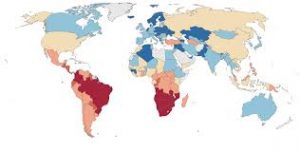Gini Index:

India has emerged as the world’s fourth most equal society, with a Gini Index of 25.5, outpacing all G7 and G20 nations, according to the World Bank.
- According to the recent World Bank report, India’s Gini Index stands at 5, placing it as the fourth most equal country globally, behind only the Slovak Republic, Slovenia, and Belarus.
- This performance not only surpasses regional peers like China, which holds a Gini score of 35.7, but also positions India ahead of every G7 and G20 nation in terms of income equality.
- It marks a steady improvement from a Gini score of 8 in 2011 to 25.5 in 2022, signalling meaningful gains in bridging income gaps over the past decade.
- The Gini index, also called the Gini coefficient or Gini ratio, determines a nation’s level of income inequality by measuring the income distribution or wealth distribution across its population.
- The Gini index was developed in 1912 by Italian statistician Corrado Gini.
- The coefficient of the Gini index ranges from 0 (or 0%) to 1 (or 100%), with 0 representing perfect equality and 1 representing perfect inequality.
- To offer two hypothetical examples, if a nation were to have absolute income equality, with every person earning the same amount, its Gini score would be 0 (0%).
- On the other hand, if one person earned all the income in a nation and the rest earned zero, the Gini coefficient would be 1 (100%).
- Mathematically, the Gini coefficient is defined based on the Lorenz curve.
- The Lorenz curve plots the percentiles of the population on the graph’s horizontal axis according to income or wealth, whichever is being measured.
- The cumulative income or wealth of the population is plotted on the vertical axis.
- The Gini index is not an absolute measure of a country’s income or wealth. The coefficient only measures the dispersion of income or wealth within a population.




